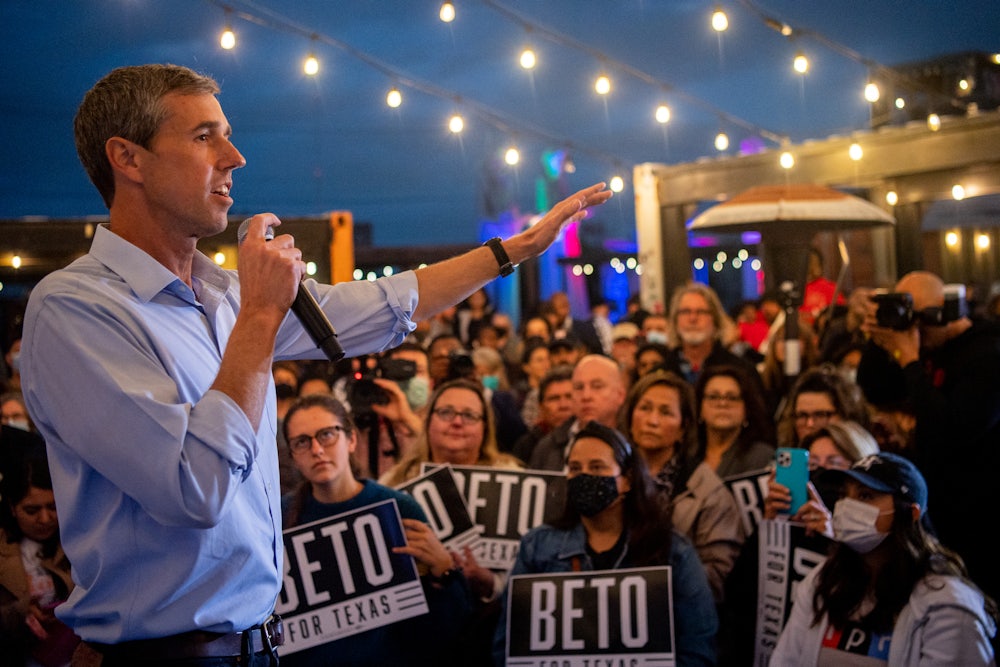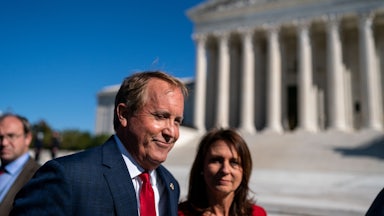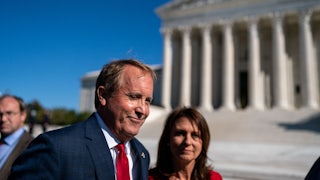In early May, Republicans in the Texas state Senate managed to baldly advance the cause of voter suppression by unanimously passing a bill that would permit the Texas secretary of state to order new elections in Harris County—and only Harris County—where the city of Houston is located. According to the measure, if just 2 percent of the region’s 783 polling places run out of ballots and fail to restock within an hour, the secretary of state is permitted to call foul and force a new election, citing irregularities. This could prove to be especially onerous in Harris County—a huge metro area with notorious infrastructure problems (it often takes more than an hour to drive from my parents’ house to City Hall, about 16 miles away). This bill essentially would permit the Republican-controlled state government to force runoff elections, which, not so coincidentally, tend to have lower voter turnouts.
This is but one of a cluster of similarly minded bills dangerously close to becoming state law. Others in this legislative session seek to prohibit local governments from adopting local ordinances that increase worker protections; green-light the removal of local prosecutors who refuse to enforce certain laws, like those banning abortion; limit polling places; and even outlaw local eviction protections, making it easier for landlords in cities to evict tenants. All are intended to kneecap cities like Austin, San Antonio, and Houston from enacting their own agendas locally, mirroring actions pursued in other Republican-controlled state governments, such as Florida and Tennessee.
“My goal is for this to be the worst session in the history of the Legislature for cities and counties,” former House Speaker Dennis Bonnen said in a leaked recording four years ago. “I hope next session’s even worse,” replied Representative Dustin Burrows, whose bill nixing local ordinances just passed a vote in the Senate this week. Each session, Republicans have doubled down on this promise. Texas Democrats knew what was coming—no one should feign surprise. But what options do they have with such few numbers in the halls of power?
Texans are used to their Democratic representatives lamenting that they’re stuck between a rock and a hard place. Republicans hold majorities in the House and Senate, and Democrats haven’t won a statewide election since 1994. Governor Greg Abbott is the most powerful governor in Texas history, having expanded his control over state committees and used his influence to bring Republican lawmakers in line. And after driving “Turn Texas Blue” mania following a close 2018 midterm against Ted Cruz, the onetime presidential hopeful and Vanity Fair wonderboy Beto O’Rourke was trounced by some 11 points in last year’s gubernatorial election. It was Texas’s most expensive campaign ever, but he hardly improved the margin compared to former Democratic candidate Lupe Valdez in 2018, who barely campaigned at all.
The conceit of the Turn Texas Blue movement was that registering more people to vote would upend the status quo, the theory being that a majority of underserved voters were secretly Democrats and thus waiting in the brush to strike. But acquiring a voter card does not a liberal make. The Texas Democratic Party remains largely insulated from people’s material needs. Some officials may say that democracy is on the line, but not all of them act like it.
This session, they’re even helping Republicans pass an exorbitantly large corporate tax break program; and most recently, some even joined in supporting a bill that would ban trans people under 18 from receiving trans-related health care. In a statement after the vote, Shawn Thierry, a House Democrat who voted in favor of the trans panic bill and touts herself as a “voice for the voiceless,” compared its aims—that is, “prohibitions” on what can be lifesaving treatment—to preventing kids from getting tattoos or cigarettes. If both parties are likely to throw you under the bus, why would you vote? Democrats need to provide a better answer to this question to the voters they’re hoping to cultivate.
There is an abundance of political cynicism among Lone Star State liberals. Texas Democrats aren’t so much a coherent political bloc fighting tooth and nail against a well-funded and cruel Goliath as they are a disorganized handful of reluctant opponents looking for a quick fix or a charismatic hero. If there’s a bright side for Texas Democrats, it’s in the urban areas, where significant reforms have passed with popular support. But this is precisely why Republicans are bent on eroding the rights of municipalities to govern themselves according to the will of their residents—though even in the cities, the Democratic Party’s latent contradictions and tangled loyalties are within plain view.
Houston has only recently shifted its position into the Democratic fold. Since 2016, formerly conservative neighborhoods in the suburbs have grown more diverse and trended blue, and in 2018, with the help of a wealth of nonprofits and activists, they elected Lina Hidalgo, a young progressive, for county judge, who oversees the region’s administrative functions. The Democrats’ political mandate grew after the 2022 elections expanded their control over the commissioner’s court to a 4–1 majority. Still, Hidalgo has faced near-constant resistance from both Republicans and her own party.
District Attorney Kim Ogg, who campaigned on progressive reforms in 2017 (though she ran as a Republican in the 1990s), has since joined Republicans to publicly accuse Hidalgo of “defunding” law enforcement—which, naturally, isn’t true—and indict three of her staffers on what Hidalgo has called “politically motivated” corruption charges. Meanwhile, Houston’s Democratic Mayor Sylvester Turner has often sided with real estate interests over working people. At the height of the pandemic, he refused to provide an eviction grace period for tenants to catch up on past-due payments (though he eventually folded to political pressure, after more than 15,000 eviction filings), and he has often bent to pressure against building affordable housing in predominantly white wealthy neighborhoods.
This is, in many ways, an old story within the Texas Democratic Party. In the 1940s, a group of wealthy conservative Democrats out of step with the overwhelming majority of Texans, who supported Franklin Roosevelt by a margin of four to one, attempted to seize control of the party and deny FDR the state’s Electoral College votes. The “Texas Regulars,” as they were called, were afraid of Communists and loathed the growing power of labor unions and working-class people; it should come as no surprise that they were largely funded by oil and business interests. When their plan failed, they left the party and, in 1948, went on to support Strom Thurmond, a vile champion of segregation, only to become Eisenhower Democrats in the 1950s.
Factionalism between party liberals and anti–Civil Rights Movement conservatives, as well as labor and business, increased through the 1960s, the competing visions making governing ever more difficult. In an article from 1998 titled, “Who killed the Texas Democratic party?” former Texas Monthly editor-in-chief Gregory Curtis wrote of the state’s post–Civil Rights era leaders: “What most needed to be done—to create and communicate new goals, ideas, programs, philosophies for the state party so that it stood for something—they were most incapable of doing.”
By the time Republicans had total control of the state legislature in 2003, oil and business interests had largely sidelined the Democrats, and a number of former Democratic state legislators had switched parties as a result, including future Republican Governor Rick Perry. Hemorrhaging support, the Democratic Party of this period tacked to the right in search of voters past. Texans watched as Dan Morales, a Democratic attorney general who railed against affirmative action, made the case that it was actually a good thing that Republicans were taking charge. Even former Governor Ann Richards, who achieved canonization among Texas liberals, had a spotty record standing against the tide that washed her party out.
Richards took a leading role in advocating for the North American Free Trade Agreement, which cost people in the United States hundreds of thousands of jobs, lowered wages, displaced around two million Mexican agricultural workers, and reduced the power of unions in Texas and elsewhere—often a major Democratic constituency. Before George W. Bush booted Richards out of the governor’s office in 1994, she faced a great deal of bad-faith right-wing criticism and failed to pass many significant reforms. Even her longtime friend and fierce liberal Molly Ivins, who famously edited The Texas Observer, acknowledged later that “[Richards] didn’t get anything done that people had dreamed of.” Richards herself told then–Texas Monthly editor Paul Burka of her time in office: “‘Am I sadder but wiser?’ The answer is yes.”
Still, her vision for a “New Texas,” more symbolic than reality, according to contemporaneous work in Texas Monthly, has obvious appeal for liberals today whose modern politicians by comparison seem to be always on the defensive.
Texas’s own history suggests that it doesn’t have to be that way. Roosevelt carried Texas in 1944 at a margin significantly greater than even Ronald Reagan did around 40 years later, and there is a strong tradition of radical working-class movements in the state. But restoring a left-liberal beachhead in Texas will require more effort than stateside Democrats have recently seemed willing to expend, as well as new ideas, grounded in the interests of the working class today, to effect necessary change in the years to come. Nevertheless, it’s what those who have recently manifested some new political energy, such as the protesters who entered the state Capitol in early May to defend trans rights and faced brutal police repression, deserve. As Texas devolves into the gun dystopia of Greg Abbott’s dreams, it’s what families in the towns of Uvalde, Allen, Cleveland, and Brownsville deserve as well—a party that fights, not just in the state Capitol every two years but daily in their communities; not building power for itself, but for its constituents.
Turning Texas blue through voter registration alone is a self-soothing idea: It’s pretty to think that the dominoes will simply fall where they must if only the favorable demographics you theorize will emerge by getting people to the ballot box can be fully unleashed. But it’s one thing to ask a Texan if they’re registered to vote; another thing entirely to convince them to vote for you. There are Democrats putting in that work, but until they assert new ideas, policies, and philosophies that they’re willing to defend and advance—wholeheartedly, for working people, at any cost—they will continue to forfeit voters as they have for decades.
Texas Democrats must burn their old playbook or suffer the consequences. Yes, Republicans are ruthlessly contorting the system in their favor, but Democrats have yet to mount a full-throated defense for their right to exist. Curtis’s 1998 Texas Monthly essay ends with a sense of foreboding: “Republicans could control Texas as long as the Democrats did, and the Democrats will have nothing to do but learn, as the Republicans had to, just how long a century really is.” If this is true, and the party continues functioning as it does at this moment, they have at least 75 years to go.










